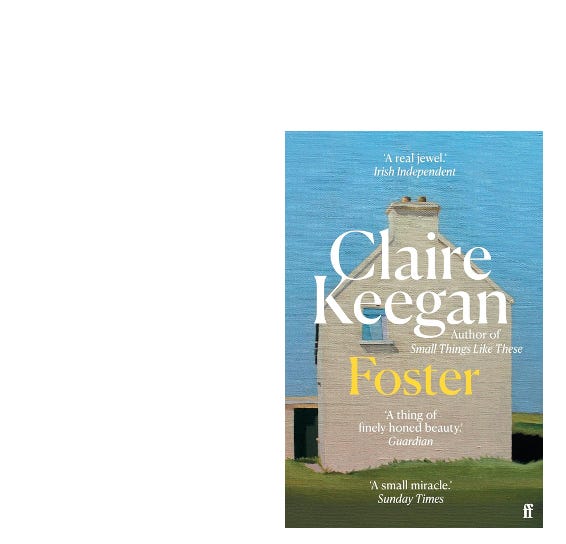[Spoilers.]
Sometimes you envy the success of another writer because you feel, I could have done that.
At other times, there’s a recognition that they have technical skills or knowledge or compassion or something unnameable that you lack.
And at yet other times, very strangely, what you have to admit is that they’ve shown greater restraint.
That is, they’ve held off from doing some of the things you habitually do, and — because of this — their work is better.
Better than it would have been if more indulgent, and perhaps simply better than yours.
Their omissions have become distinctive in a way that your inclusions have not.
Which is how I am currently feeling about Claire Keegan’s Foster.
Foster is a long short story or a short novella — published as a book — based on continual pulling back.
Emotional and stylistic drawing back.
However, all of this takes exactly the force that goes into pulling back the string of a longbow.
The initial movement of the hand is away from the target. But the drawing back results in a build-up of potential energy.
As such, Foster reminds me of other 100-ish pages stories such as Turgenev’s First Love and Henry James’ The Turn of the Screw.
Both aim towards a single moment of release, flight and accuracy.
(Foster, I should say, is about a girl who spends a summer on a farm with an older couple who have, she finds out, lost a son. The couple treat her better than her own parents, who have too many children to cope.)
While I was reading Foster, I admired the details of individual sentences. They aren’t uncommunicative. But neither are they expressive.
Not in the way the final paragraph is.
Interestingly, that contains a comma splice — the non-separation of two grammatically correct sentences —
‘Daddy,’ I warn him, I call him. ‘Daddy.’
As far as I can tell, no-one has remarked on this — probably because most people were too tearful at that moment to be able to focus on the gone-starry page.
I think that the comma is a pivot point, showing that conventional grammar can no longer hold the together the messy expressiveness of what needs to be said.
At the same time, the girl is making a gesture of warding off (warn) and of bringing in (call). They need to be equivalent rather than subsequent. If the words could exist on top of one another, I think they would.
The climactic outburst is very like — is perhaps a quotation — from The Railway Children (1970).
An entire generation was enraptured by Jenny Agutter running along the emptied platform and crying out, ‘Daddy! — my Daddy!’
There are other filmic resonances in this final scene. If one was being coldly analytical, and slightly cynical, one might liken the main character’s sprint to catch up at the gate with driving-away Kinsella — the man in the couple who have looked after her all summer — as the Race for Your Love or Desperate Airport Dash of Romantic Comedies.
Some people I’ve spoken to felt that final cry was too much. I don’t agree — I think it’s necessary to finally name that which has been suppressed, and name it with love.
It’s in the figure of the father that the book, to me, is most fascinating.
The literary technique of restraint seems easily comprehensible, and you could imitate it if you wanted. What is much harder — well, impossible — to do anything but admire is the way that Claire Keegan gathers together so much cultural as well as narrative force.
We now expect father figures in stories to be bad, to be abusive.
Adoptive fathers, uncles, older men who are around.
The idea, the shape of fatherhood itself is questionable — and often related to psychic dominance, to physical violence, and even to fascism. (The Strong Man as Father of the Nation, the Fatherland.)
We’ve come to expect couples in stories who take in children to mistreat, exploit or be maliciously cruel to them.
As the Dursleys are cruel to Harry Potter.
Charles Dickens, both in his life and his fiction, is behind much of this.
But there’s also a simple narrative challenge — if a child is sent away for the summer to be looked after by an elderly couple who treat them well, where is the story?
Well, in Foster the story — the excruciating story — is our parallel reading of an imaginary bad father alongside and often on top of an actual (though fictional) good man.
We expect and project the worst.
A friendly chat will turn into gaslighting. A hug will become a grope.
It is in the gathering of this horrible force — incorporating it, too, into the pulling back of the bowstring that Foster is great.
All along, we thought this fictional world a more evil place than it is, and we were proven wrong.
Perhaps that means our real world can be better, too.
Perhaps we too can have good father figures, good men.


